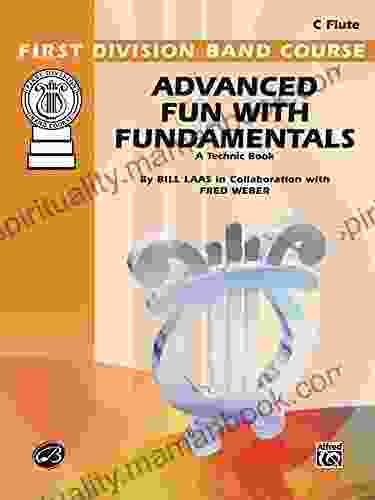Fine Tuning the Clarinet Section: A Comprehensive Guide to Intonation and Ensemble Playing

The clarinet is a versatile and expressive woodwind instrument that plays a vital role in many musical ensembles. However, achieving perfect intonation and balance within a clarinet section can be a challenge, especially for young or inexperienced players. This guide will provide comprehensive strategies and techniques for fine tuning the clarinet section, ensuring optimal intonation and harmonious ensemble playing.
5 out of 5
| Language | : | English |
| File size | : | 110363 KB |
| Text-to-Speech | : | Enabled |
| Screen Reader | : | Supported |
| Word Wise | : | Enabled |
| Print length | : | 124 pages |
Intonation Issues and Their Causes
Intonation refers to the accuracy of pitch in relation to a reference point, typically the A440 tuning standard. Common intonation issues encountered in clarinet sections include:
* Sharpness: Notes played higher than the intended pitch. * Flatness: Notes played lower than the intended pitch. * Wolf tones: Certain notes that are particularly difficult to play in tune due to acoustic anomalies.
These issues can arise from various factors, including:
* Embouchure: The positioning of the lips and teeth on the mouthpiece. * Reed strength: Soft reeds promote sharper intonation, while hard reeds produce flatter intonation. * Reed adjustment: Trimming or shaping the reed can affect intonation. * Instrument adjustments: Leaks or misaligned keys can impact intonation. * Temperature and humidity: Extreme temperatures or changes in humidity can alter the instrument's dimensions and intonation.
Strategies for Fine Tuning
To achieve optimal intonation, clarinet section players should implement the following strategies:
1. Establish a Common Tuning Reference
Use a reliable tuning device, such as a tuner or a drone, to establish a consistent reference pitch for the entire section. All players should tune their instruments to the same pitch before rehearsals and performances.
2. Warm Up Together
Begin rehearsals with a structured warm-up routine that includes playing long tones, scales, and arpeggios together. This helps players establish a common embouchure and reed strength, promoting intonation stability.
3. Use Intonation Exercises
Incorporate intonation drills into rehearsals. These exercises focus on challenging passages or specific notes that are prone to intonation issues. Players should practice these exercises slowly, gradually increasing the tempo as intonation improves.
4. Listen Actively
Encourage players to listen attentively to each other and to the ensemble as a whole. This promotes self-awareness and allows players to make subtle adjustments to their intonation based on the overall sound.
5. Adjust Embouchure and Reed
If intonation issues persist, players may need to adjust their embouchure or reed. Make small changes to the shape, firmness, or position of the embouchure. Experiment with different reed strengths to find the optimal fit for the instrument and player's embouchure.
6. Check Instrument Adjustments
Inspect the instruments regularly for leaks, misaligned keys, or other issues that may affect intonation. Seek professional assistance if necessary to ensure proper adjustment and maintain the instrument in good condition.
Ensemble Playing Considerations
In addition to fine tuning the individual clarinets, attention should also be paid to the overall balance and blend of the clarinet section within the ensemble:
1. Encourage Blending
Players should strive to produce a consistent tone quality and volume. This requires matching articulation, phrasing, and dynamics, ensuring a smooth and cohesive sound.
2. Balance the Sections
The clarinet section's volume and balance should complement the other sections of the ensemble. Adjust the number of clarinets playing or use seating arrangements to achieve the desired balance.
3. Utilize Section Leaders
Appoint experienced players as section leaders to guide younger or less experienced players. Section leaders can provide cues, maintain discipline, and encourage consistent intonation and ensemble playing.
Fine tuning the clarinet section is an ongoing process that requires patience, practice, and attention to detail. By implementing the strategies and techniques outlined in this guide, clarinet players can achieve optimal intonation and balance, contributing to a harmonious and expressive ensemble performance. Remember, fine tuning is not just about playing the correct notes. It's about creating a cohesive and musically satisfying experience for the audience.
5 out of 5
| Language | : | English |
| File size | : | 110363 KB |
| Text-to-Speech | : | Enabled |
| Screen Reader | : | Supported |
| Word Wise | : | Enabled |
| Print length | : | 124 pages |
Do you want to contribute by writing guest posts on this blog?
Please contact us and send us a resume of previous articles that you have written.
 Top Book
Top Book Novel
Novel Fiction
Fiction Nonfiction
Nonfiction Literature
Literature Paperback
Paperback Hardcover
Hardcover E-book
E-book Audiobook
Audiobook Bestseller
Bestseller Classic
Classic Mystery
Mystery Thriller
Thriller Romance
Romance Fantasy
Fantasy Science Fiction
Science Fiction Biography
Biography Memoir
Memoir Autobiography
Autobiography Poetry
Poetry Drama
Drama Historical Fiction
Historical Fiction Self-help
Self-help Young Adult
Young Adult Childrens Books
Childrens Books Graphic Novel
Graphic Novel Anthology
Anthology Series
Series Encyclopedia
Encyclopedia Reference
Reference Guidebook
Guidebook Textbook
Textbook Workbook
Workbook Journal
Journal Diary
Diary Manuscript
Manuscript Folio
Folio Pulp Fiction
Pulp Fiction Short Stories
Short Stories Fairy Tales
Fairy Tales Fables
Fables Mythology
Mythology Philosophy
Philosophy Religion
Religion Spirituality
Spirituality Essays
Essays Critique
Critique Commentary
Commentary Glossary
Glossary Bibliography
Bibliography Index
Index Table of Contents
Table of Contents Preface
Preface Introduction
Introduction Foreword
Foreword Afterword
Afterword Appendices
Appendices Annotations
Annotations Footnotes
Footnotes Epilogue
Epilogue Prologue
Prologue Micah Toll
Micah Toll Nowick Gray
Nowick Gray Dreda Say Mitchell
Dreda Say Mitchell Boye Lafayette De Mente
Boye Lafayette De Mente Danielle Gibson
Danielle Gibson Beate Ziebell
Beate Ziebell James Burke
James Burke Adrian Newey
Adrian Newey Frank Scozzari
Frank Scozzari Richard Dunlop
Richard Dunlop Michael Medina
Michael Medina Jennifer Weiner
Jennifer Weiner Jean Marie Bauhaus
Jean Marie Bauhaus Caryl Phillips
Caryl Phillips Cixin Liu
Cixin Liu Patricia Regier
Patricia Regier Deborah Plummer
Deborah Plummer Ronald Reagan
Ronald Reagan Kinshasha Holman Conwill
Kinshasha Holman Conwill Larry Sitsky
Larry Sitsky
Light bulbAdvertise smarter! Our strategic ad space ensures maximum exposure. Reserve your spot today!

 Forrest ReedEssential Wardrobe Pieces for Timeless Style and Comfort: Shirts, Jackets,...
Forrest ReedEssential Wardrobe Pieces for Timeless Style and Comfort: Shirts, Jackets,...
 Chris ColemanQuick Guide To Opening Doors And Closing Deals: A Comprehensive Guide for...
Chris ColemanQuick Guide To Opening Doors And Closing Deals: A Comprehensive Guide for... Jackson HayesFollow ·13.1k
Jackson HayesFollow ·13.1k Ross NelsonFollow ·9.5k
Ross NelsonFollow ·9.5k Samuel WardFollow ·17.9k
Samuel WardFollow ·17.9k Ismael HayesFollow ·3.3k
Ismael HayesFollow ·3.3k Dion ReedFollow ·16.9k
Dion ReedFollow ·16.9k Owen SimmonsFollow ·6.8k
Owen SimmonsFollow ·6.8k George MartinFollow ·17.3k
George MartinFollow ·17.3k Tyrone PowellFollow ·15.7k
Tyrone PowellFollow ·15.7k

 Thomas Powell
Thomas PowellHair Care Essentials for Crochet Braids: A Protective...
Crochet braids are a versatile and...

 Philip Bell
Philip BellNative Nations of North America: A Comprehensive Guide
North America is home to a...

 Jackson Hayes
Jackson HayesCall Me Crazy: My Unique Journey with Green
In the kaleidoscopic tapestry of life, where...

 Graham Blair
Graham BlairUnveiling the Literary Treasures of Michigan: A Journey...
The literary landscape of...
5 out of 5
| Language | : | English |
| File size | : | 110363 KB |
| Text-to-Speech | : | Enabled |
| Screen Reader | : | Supported |
| Word Wise | : | Enabled |
| Print length | : | 124 pages |











